Imaging Top of Volcanic Mounds Using Seismic Time- and Depth-Domain Data Processing
Abstract
1. Introduction
2. Structural and Geological Characteristics

3. Results of Seismic Data Processing
3.1. Time-Domain Processing
3.2. Depth-Domain Processing Using the MVA Technique
4. Seismic Interpretation
5. Discussion
6. Conclusions
Author Contributions
Funding
Institutional Review Board Statement
Informed Consent Statement
Data Availability Statement
Acknowledgments
Conflicts of Interest
References
- US Government. How Much of the Earth is Volcanic? Available online: https://www.usgs.gov/faqs/how-much-earth-volcanic?qt-news_science_products=0#qt-news_science_products (accessed on 18 March 2021).
- Blaikie, T.N.; Ailleres, L.; Betts, P.G.; Cas, R.A.F. Interpreting subsurface volcanic structures using geologically constrained 3-D gravity inversions: Examples of maar-diatremes, Newer Volcanics Province, Southeastern Australia. J. Geophys. Res. Solid Earth 2014, 119, 3857–3878. [Google Scholar] [CrossRef]
- Aiello, G.; Angelino, A.; D’Argenio, B.; Marsella, E.; Pelosi, N.; Ruggieri, S.; Siniscalchi, A. Buried volcanic structures in the Gulf of Naples (Southern Tyrrhenian Sea, Italy) resulting from high resolution magnetic survey and seismic profiling. Ann. Geophys. 2005, 48, 883–897. [Google Scholar]
- Tsuru, T.; No, T.; Fujie, G. Geophysical imaging of subsurface structures in volcanic area by seismic attenuation profiling. Earth Planets Space 2017, 69, 1–12. [Google Scholar] [CrossRef]
- Klamer, S.; Klamer, O. Identification of paleo-volcanic rocks on seismic data. In Updates in Volcanology—A Comprehensive Approach to Volcanological Problems, 1st ed.; Stoppa, F., Ed.; InTech: Rijeka, Croatia, 2012. [Google Scholar]
- Bruno, P.P.G.; Cippitelli, G.; Rapolla, A. Seismic study of the Mesozoic carbonate basement around Mt. Somma-Vesuvius, Italy. J. Volcanol. Geotherm. Res. 1998, 84, 311–322. [Google Scholar] [CrossRef]
- Lomax, A.; Zollo, A.; Capuano, P.; Virieux, J. Precise, absolute earthquake location under Somma-Vesuvius volcano using a new three-dimensional velocity model. Geophys. J. Int. 2001, 146, 313–331. [Google Scholar] [CrossRef]
- Hooft, E.E.E.; Heath, B.A.; Toomey, D.R.; Paulatto, M.; Papazachos, C.B.; Nomikou, P.; Morgan, J.V.; Warner, M.R. Seismic imaging of Santorini: Subsurface constraints on caldera collapse and present-daymagma recharge. Earth Planet. Sci. Lett. 2019, 514, 48–61. [Google Scholar] [CrossRef]
- Tartarello, M.C.; Palisant, A.; Bigi, S.; Beaubien, S.E.; Graziani, S.; Lombardi, S.; Ruggiero, L.; De Angelis, D.; Sacco, P.; Maggio, E. Preliminary results of geological characterization and geochemical monitoring of Sulcis Basin (Sardinia), as a potential CCS site. Ener. Proc. 2017, 125, 549–555. [Google Scholar] [CrossRef]
- McGrail, B.P.; Schaef, H.T.; Ho, A.M.; Chien, Y.; Dooley, J.J.; Davidson, C.L. Potential for carbon dioxide sequestration in flood basalts. J. Geophys. Res. Space Phys. 2006, 111, B12201. [Google Scholar] [CrossRef]
- Busch, A.; Amann, A.; Bertier, P.; Waschbusch, M.; Krooss, B.M. The significance of caprock sealing integrity for CO2 storage. In Proceedings of the SPE International Conference on CO2 Capture, Storage and Utilization, New Orleans, LA, USA, 10–12 November 2010. [Google Scholar]
- Matter, J.M.; Stute, M.; Snaebjornsdottir, S.O.; Oelkers, E.H.; Gislason, S.R.; Aradottir, E.S.; Sigfusson, B.; Gunnarsson, I.; Sigurdardottir, H.; Gunnlaugsson, E.; et al. Rapid carbon mineralization for permanent disposal of anthropogenic carbon dioxide emissions. Science 2016, 352, 1312–1314. [Google Scholar] [CrossRef]
- Jayne, R.S.; Wu, H.; Pollyea, R.M. Geologic CO2 sequestration and permeability uncertainty in a highly heterogeneous reservoir. Int. J. Green. Gas. Cont. 2019, 83, 128–139. [Google Scholar] [CrossRef]
- Kang, M.; Kim, J.H.; Kim, K.; Cheong, S.; Shinn, Y.J. Assessment of CO2 storage capacity for basalt caprock-sandstone reservoir system in the northern East China Sea. In Proceedings of the EGU General Assembly Conference Abstract, Vienna, Austria, 8–13 April 2018; p. 5772. [Google Scholar]
- Huh, D.; Park, Y.; Yoo, D.; Hwang, S. CO2 geological storage potential in Korea. Ener. Proc. 2011, 4, 4881–4888. [Google Scholar] [CrossRef]
- Litt, T.; Krastel, S.; Sturm, M.; Kipfer, R.; Orcen, S.; Heumann, G.; Franz, S.O.; Ulgen, U.B.; Niessen, F. ‘PALEOVAN’, International Continental Scientific Drilling Program (ICDP): Site survey results and perspectives. Quat. Sci. Rev. 2009, 28, 1555–1567. [Google Scholar] [CrossRef]
- Stork, C.; Clayton, R.W. Linear aspects of tomographic velocity analysis. Geophysics 1991, 56, 483–495. [Google Scholar] [CrossRef]
- Stork, C. Reflection tomography in the postmigrated domain. Geophysics 1992, 57, 680–692. [Google Scholar] [CrossRef]
- Niino, H.; Emery, K.O. Sediments of shallow portions of East China Sea and South China Sea. Geol. Soc. Am. Bull. 1961, 72, 731–762. [Google Scholar] [CrossRef]
- Cukur, D.; Horozal, S.; Kim, D.C.; Han, H.C. Seismic stratigraphy and structural analysis of the northern East China Sea Shelf Basin interpreted from multi-channel seismic reflection data and cross-section restoration. Mar. Pet. Geol. 2011, 28, 1003–1022. [Google Scholar] [CrossRef]
- Lee, G.H.; Kim, B.; Shin, K.S.; Sunwoo, D. Geologic evolution and aspects of the petroleum geology of the northern East China Sea shelf basin. AAPG Bull. 2006, 90, 237–260. [Google Scholar] [CrossRef]
- Lee, C.; Shinn, Y.J.; Han, H.-C. Structural evolution of two-stage rifting in the northern East China Sea Shelf Basin. Geol. J. 2019, 54, 2229–2240. [Google Scholar] [CrossRef]
- Korea Institute of Geoscience and Mineral Resources. Hydrocarbon Potential of the Northern East China Shelf Basin, I; KIGAM Report; KIGAM: Daejeon, Korea, 1997; (written in Korean with English abstract). [Google Scholar]
- Shin, S.Y.; Kang, M.; Shinn, Y.J.; Cheong, S. Assessment of CO2 geological storage capacity for basalt flow structure around PZ-1 exploration well in the Southern Continental Shelf of Korea. Econ. Environ. Geol. 2020, 53, 33–43, (written in Korean with English abstract). [Google Scholar]
- Dix, C.H. Seismic velocities from surface measurements. Geophysics 1955, 20, 68–86. [Google Scholar] [CrossRef]
- Vidale, J. Finite-difference calculation of traveltimes in three dimensions. Geophysics 1990, 55, 521–526. [Google Scholar] [CrossRef]
- Gray, S.H.; May, W.P. Kirchhoff migration using eikonal equation traveltimes. Geophysics 1994, 59, 810–817. [Google Scholar] [CrossRef]
- Yilmaz, O. Seismic Data Analysis: Processing, Inversion, and Interpretation of Seismic Data, 2nd ed.; SEG: Tulsa, OK, USA, 2001. [Google Scholar]
- Virieux, J.; Operto, S. An overview of full-waveform inversion in exploration geophysics. Geophysics 2009, 74, WCC127–WCC152. [Google Scholar] [CrossRef]
- Son, W.; Pyun, S.; Shin, C.; Kim, H. Laplace-domain wave-equation modeling and full waveform inversion in 3D isotropic elastic media. J. Appl. Geophys. 2014, 105, 120–132. [Google Scholar] [CrossRef]
- Zhou, H.; Pham, D.; Gray, S. Tomographic velocity analysis in strongly anisotropic TTI media. In Proceedings of the 74th Annual International Meeting of the SEG, Expanded Abstracts, Denver, CO, USA, 10–15 October 2004; pp. 2347–2350. [Google Scholar]
- Li, Y.; Biondi, B. Migration velocity analysis for anisotropic models. In Proceedings of the 81st Annual International Meeting of the SEG, Expanded Abstracts, San Antonio, TX, USA, 18–23 September 2011; pp. 201–206. [Google Scholar]
- Wessel, P.; Smith, W.H.F.; Scharroo, R.; Luis, J.; Wobbe, F. Generic mapping tools: Improved version released. EOS Trans. AGU 2013, 94, 409–410. [Google Scholar] [CrossRef]
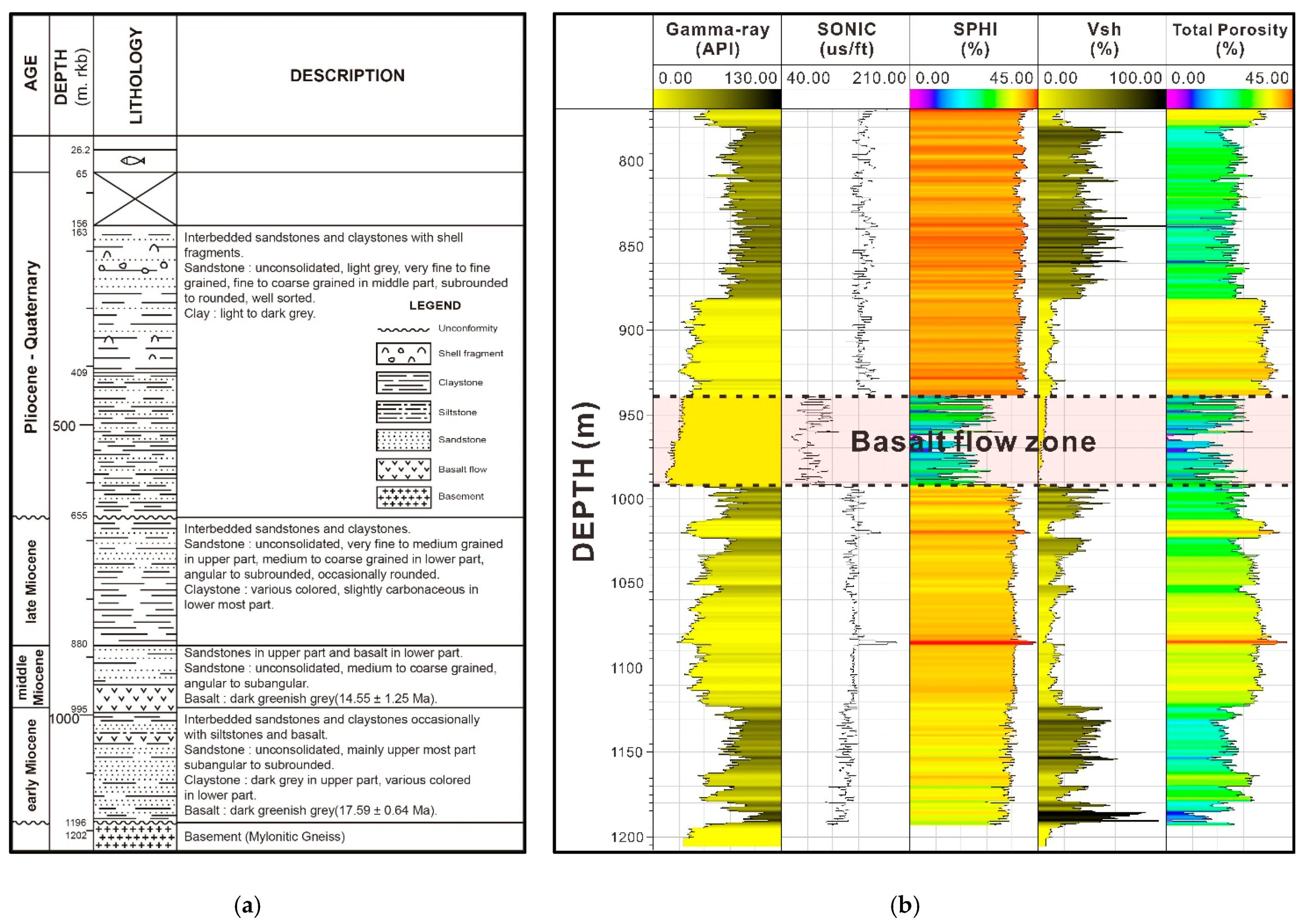
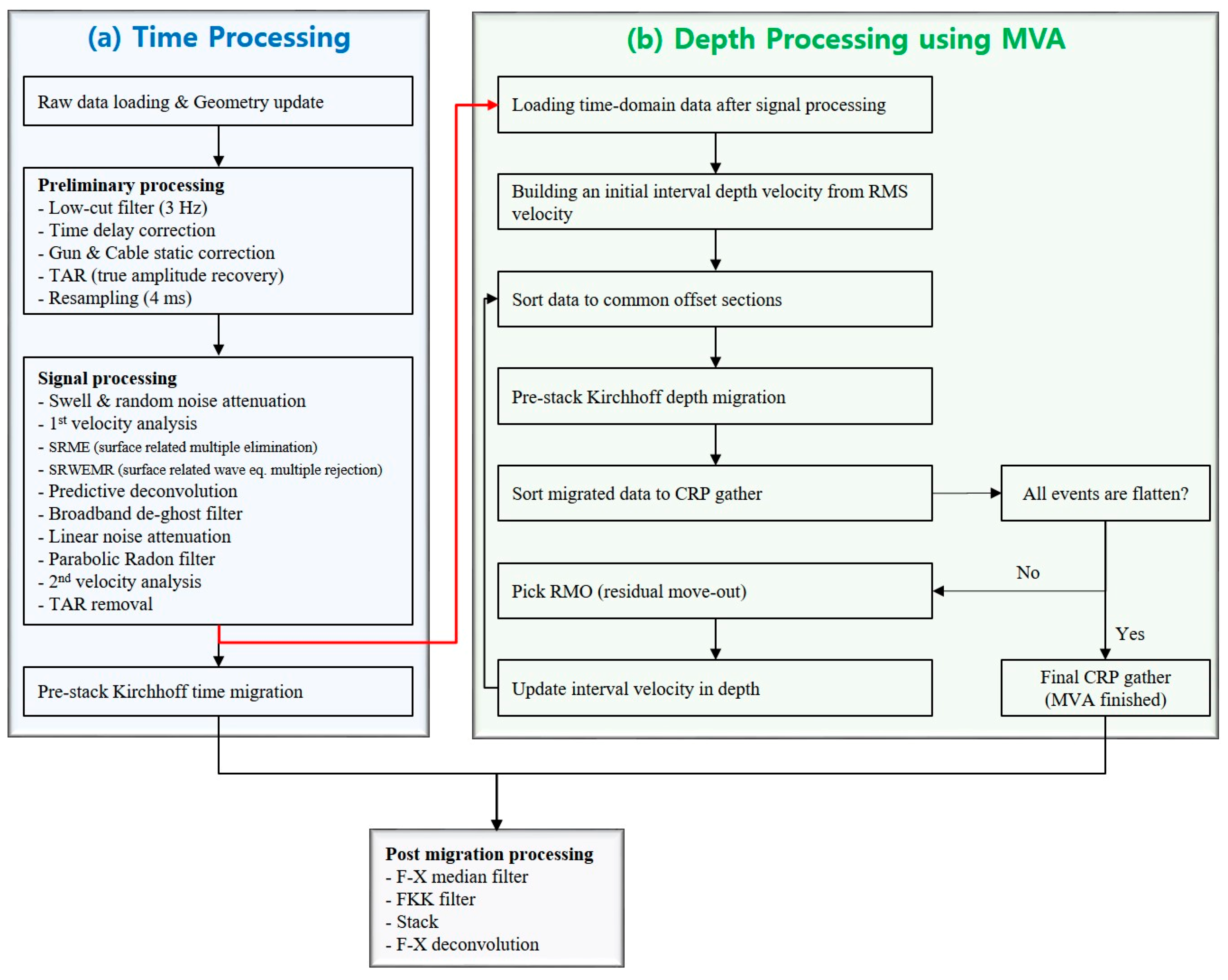


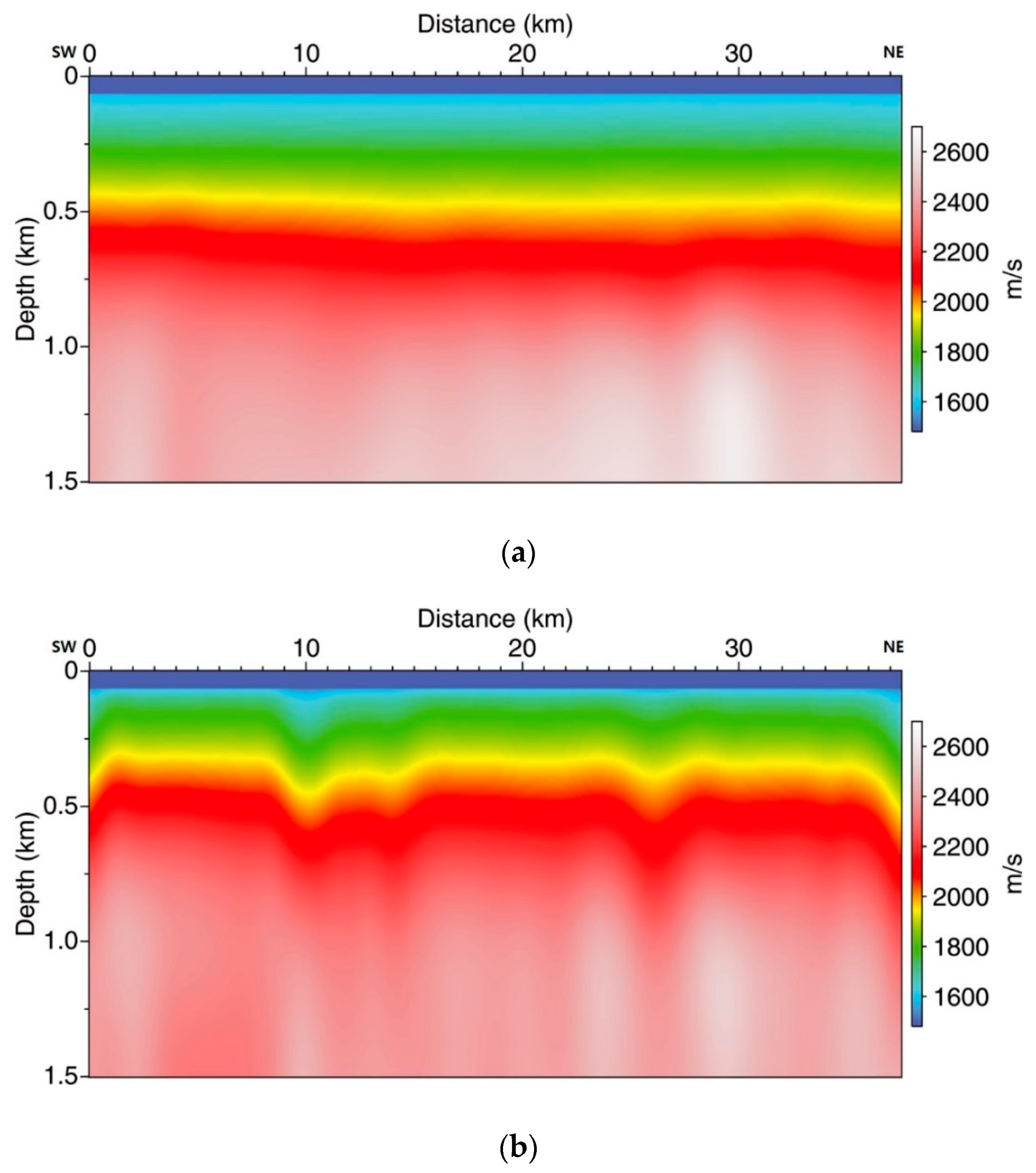
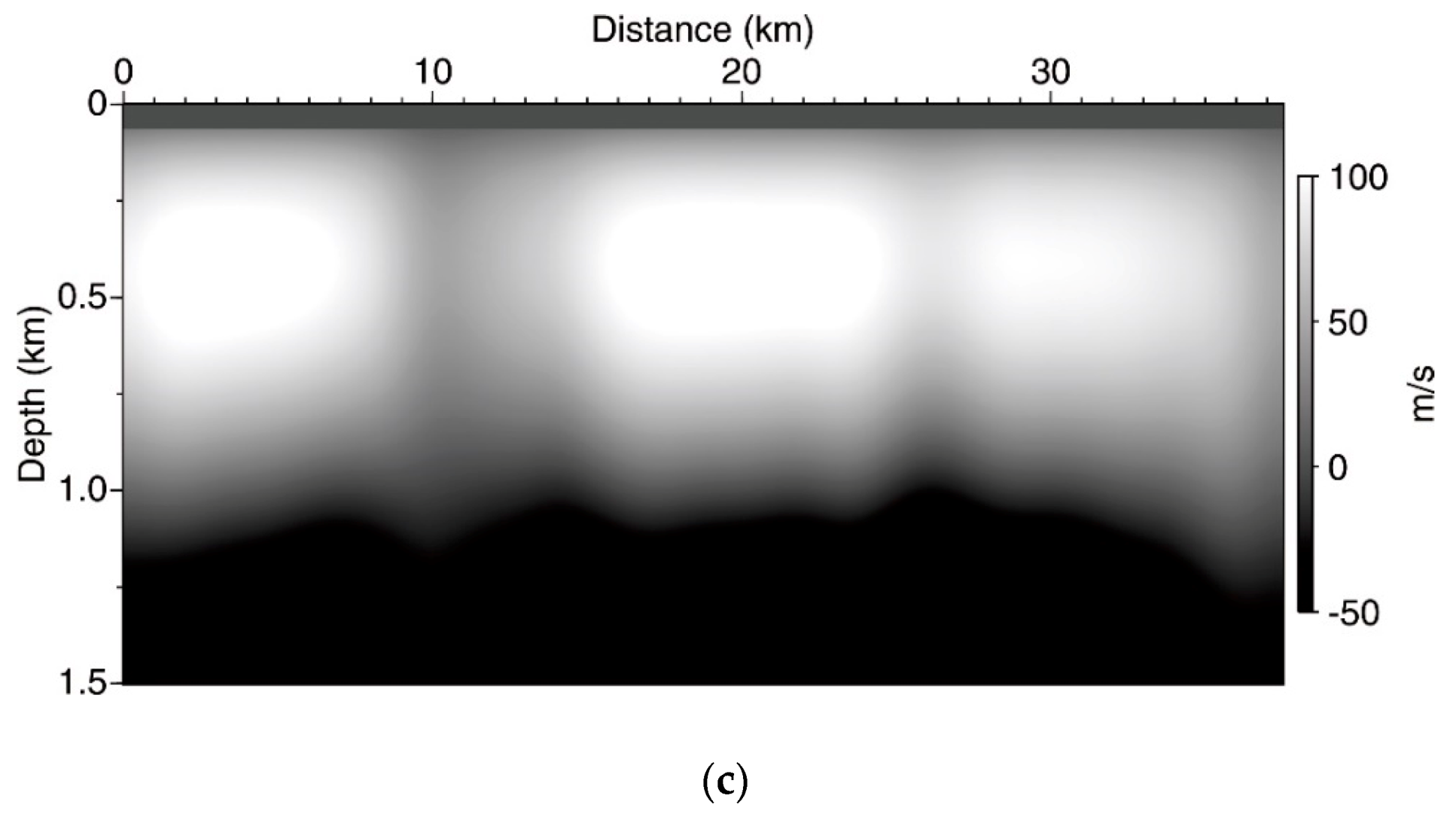
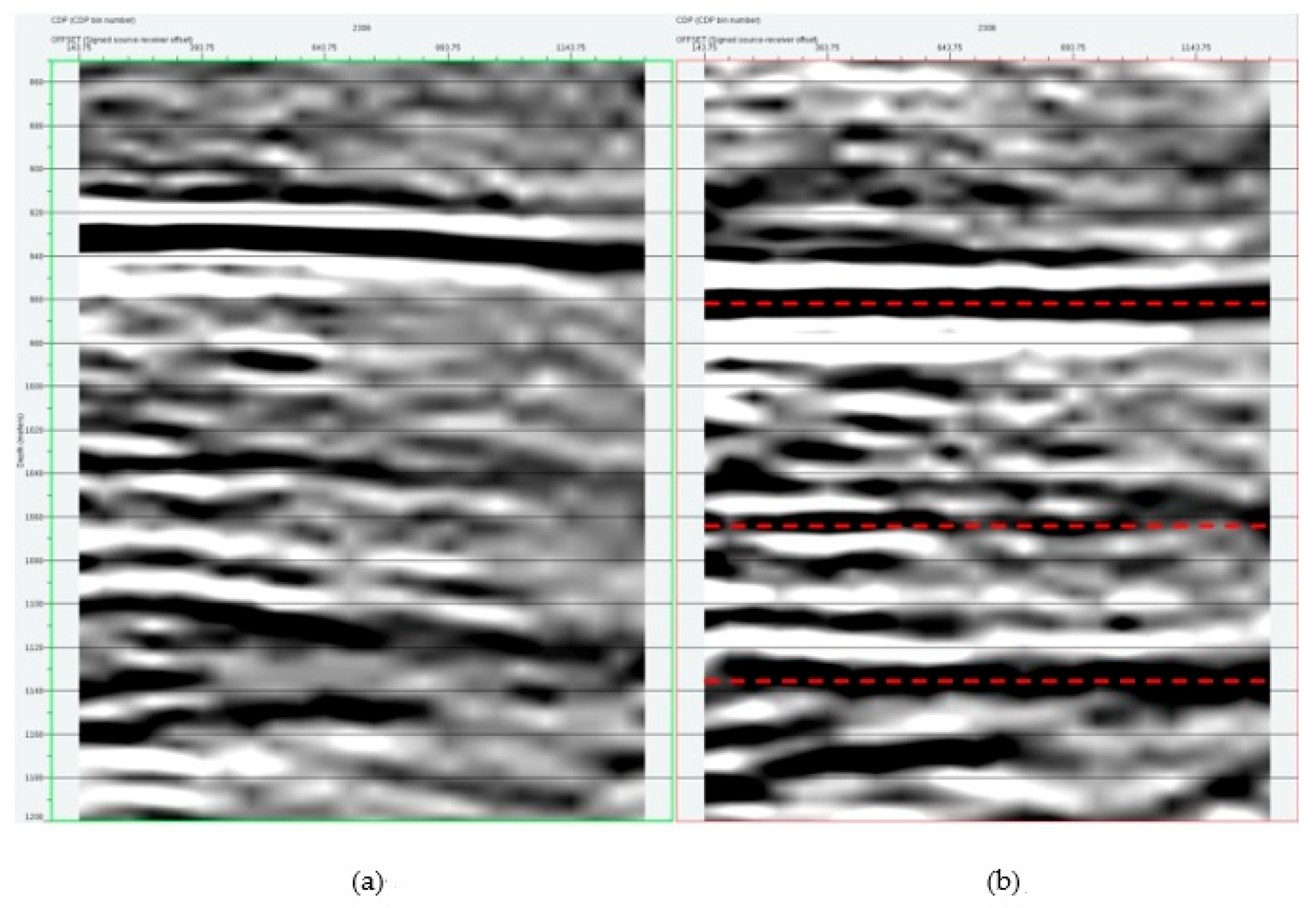
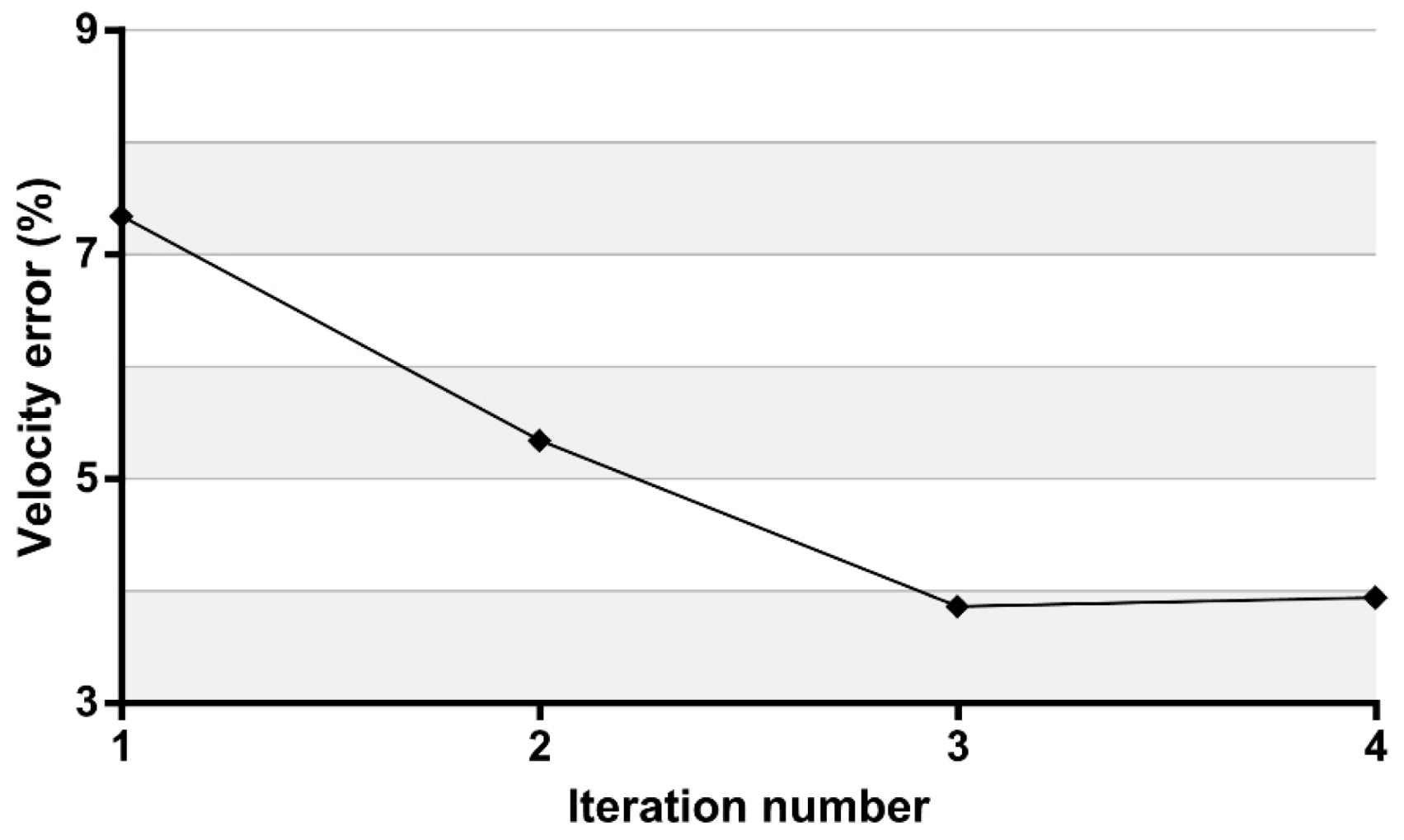
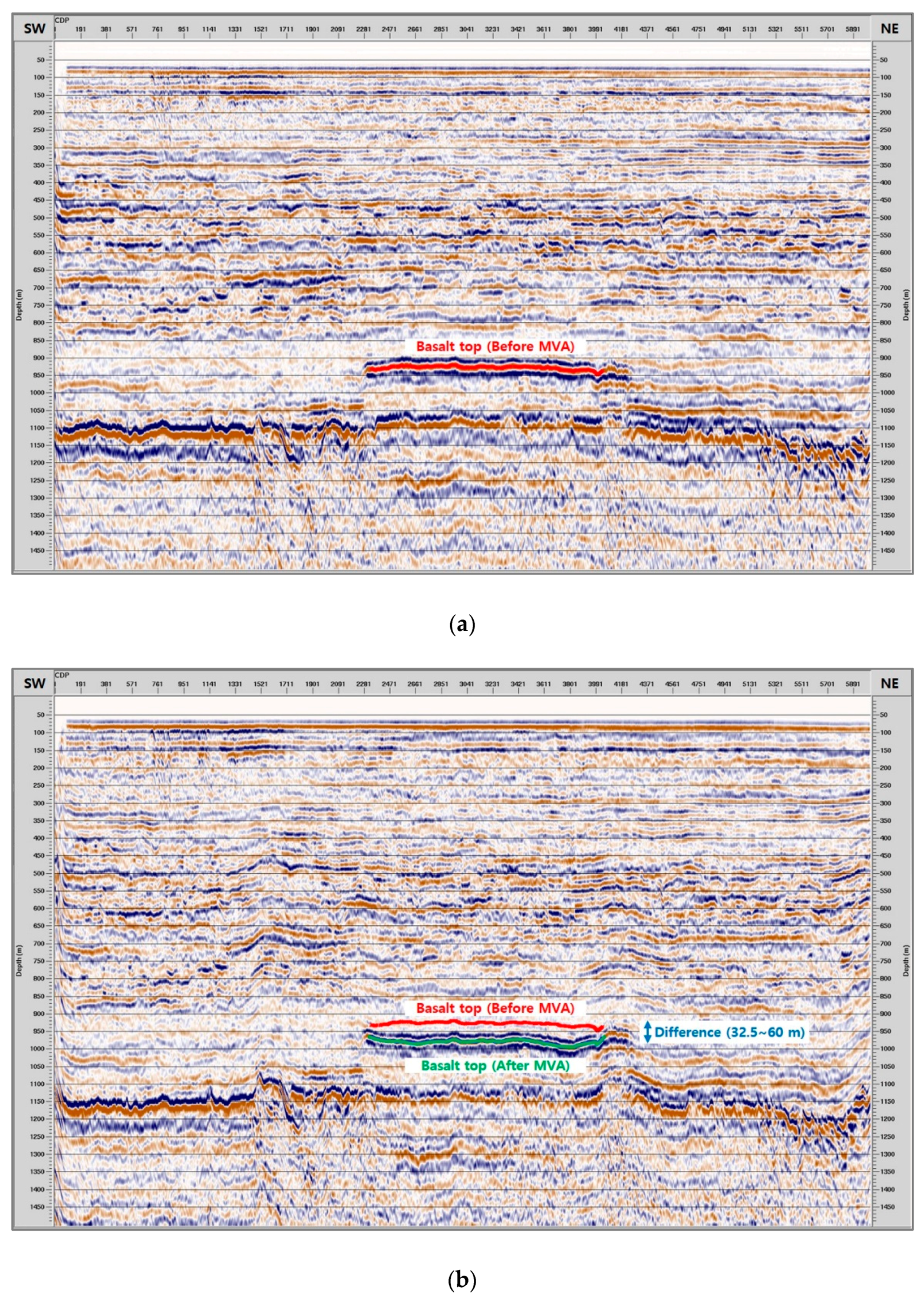
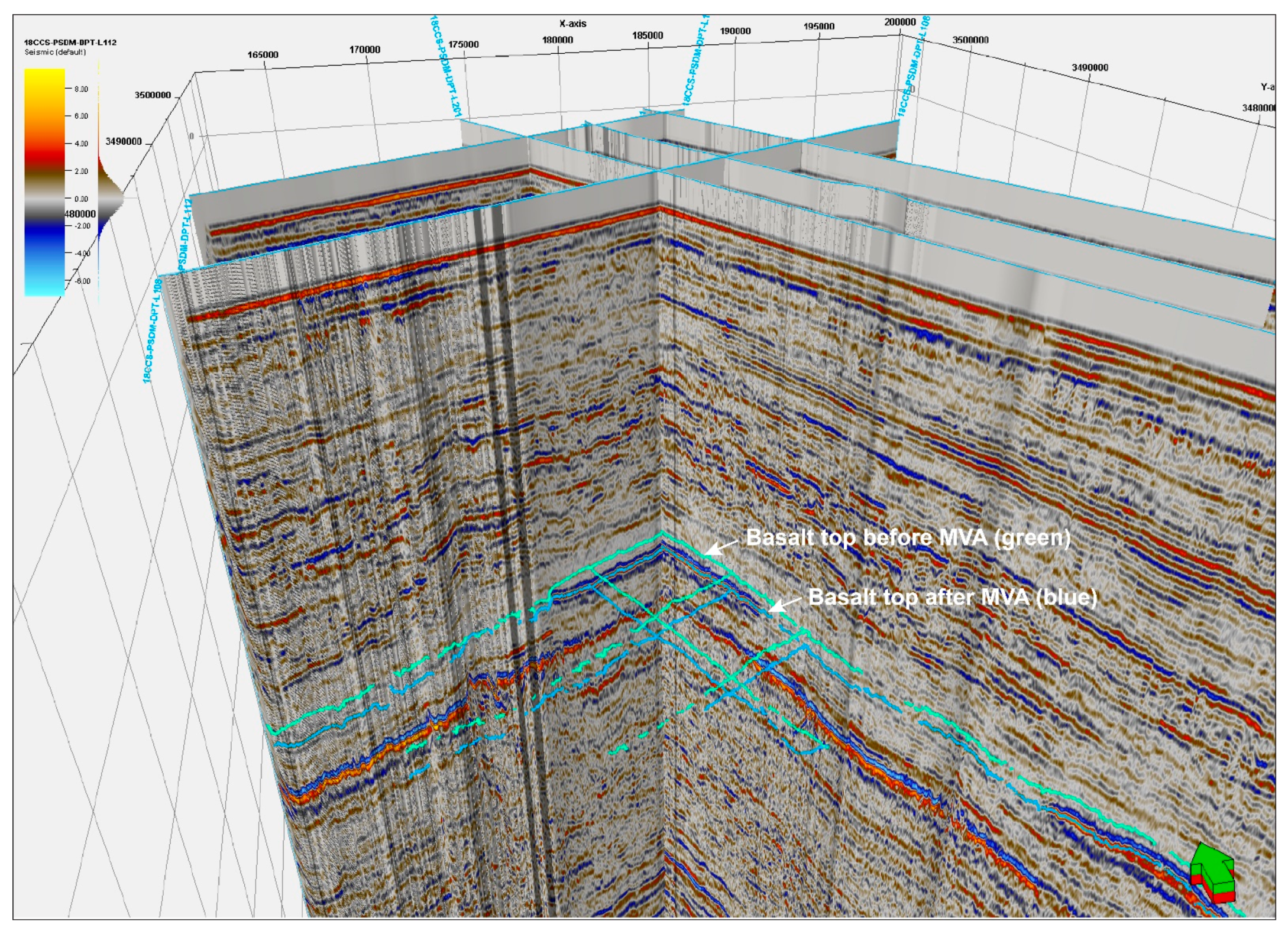

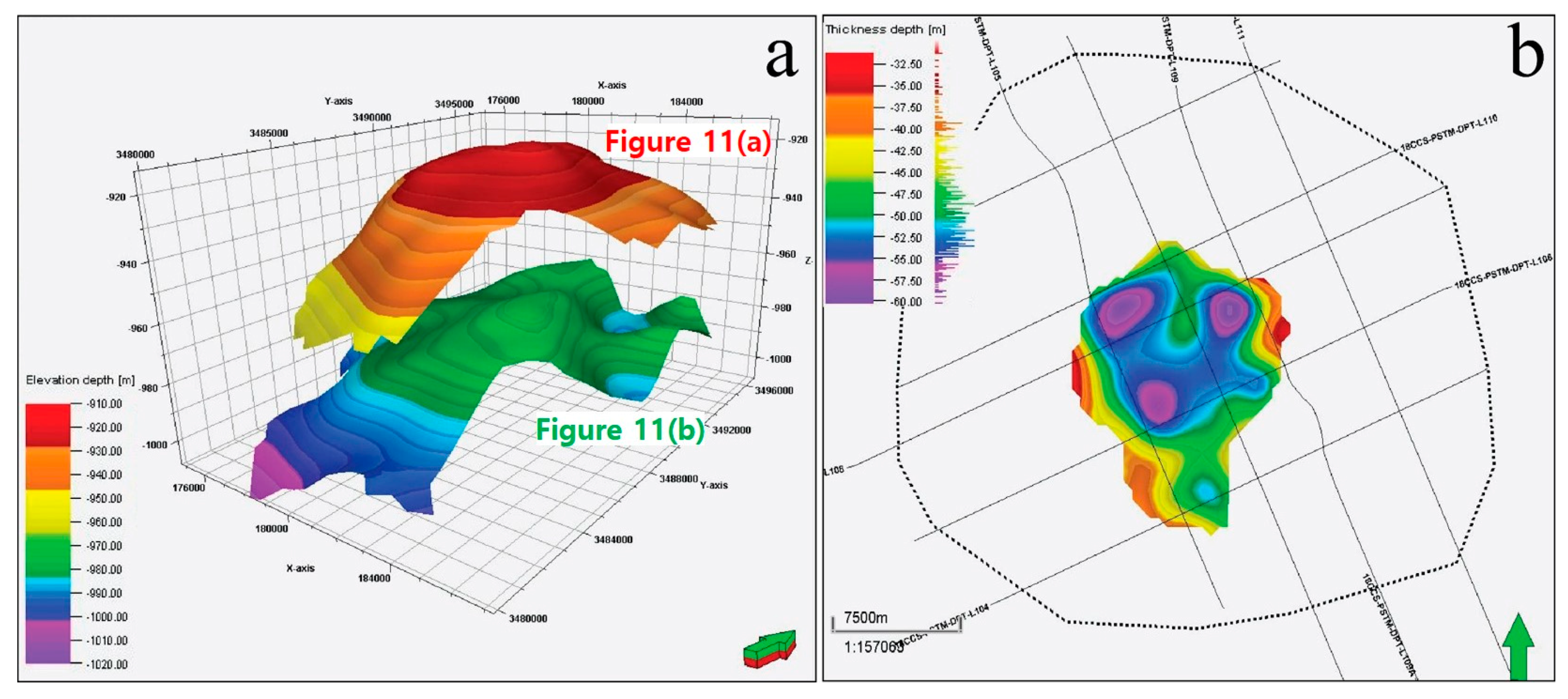
| Parameter | Description | Value |
|---|---|---|
| Streamer | Streamer length (m) | 1200 |
| No. of channels | 96 | |
| Group interval (m) | 12.5 | |
| Offset ranges (m) | 125~1325 | |
| Streamer depth (m) | 7 ± 1 | |
| Recording | Recording length (s) | 5 |
| Sampling rate (ms) | 1 | |
| Source | Source type | Bolt long-life air guns |
| Source volume (cu. in.) | 1254 | |
| Source depth (m) | 5 | |
| Source interval (m) | 25 |
Publisher’s Note: MDPI stays neutral with regard to jurisdictional claims in published maps and institutional affiliations. |
© 2021 by the authors. Licensee MDPI, Basel, Switzerland. This article is an open access article distributed under the terms and conditions of the Creative Commons Attribution (CC BY) license (https://creativecommons.org/licenses/by/4.0/).
Share and Cite
Son, W.; Cheong, S.; Lee, C.; Kang, M. Imaging Top of Volcanic Mounds Using Seismic Time- and Depth-Domain Data Processing. Appl. Sci. 2021, 11, 4244. https://doi.org/10.3390/app11094244
Son W, Cheong S, Lee C, Kang M. Imaging Top of Volcanic Mounds Using Seismic Time- and Depth-Domain Data Processing. Applied Sciences. 2021; 11(9):4244. https://doi.org/10.3390/app11094244
Chicago/Turabian StyleSon, Woohyun, Snons Cheong, Changyoon Lee, and Moohee Kang. 2021. "Imaging Top of Volcanic Mounds Using Seismic Time- and Depth-Domain Data Processing" Applied Sciences 11, no. 9: 4244. https://doi.org/10.3390/app11094244
APA StyleSon, W., Cheong, S., Lee, C., & Kang, M. (2021). Imaging Top of Volcanic Mounds Using Seismic Time- and Depth-Domain Data Processing. Applied Sciences, 11(9), 4244. https://doi.org/10.3390/app11094244






